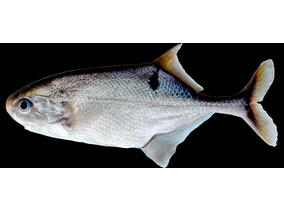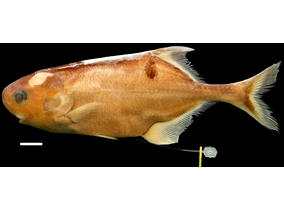You are here
Mormyridae
Petrocephalus pulsivertens Lavoué, Sullivan & Arnegard, 2010
Nomenclature
-
Subfamily: PetrocephalinaeGenus: Petrocephalus
SUMMARY
Petrocephalus pulsivertens is a relatively large sized species within the genus Petrocephalus (maximum standard length = 114.8 mm, the length of the holotype). Body ovoid, body 2.6-2.9 longer than high (holotype = 2.8) and laterally compressed. Head length between 3.6 and 3.7 times in standard length (holotype = 3.7). Eye large (3.2 ≤ head length/eye diameter ≤ 3.5, average = 3.4, holotype = 3.5). Snout short and round. Mouth large (3.0 ≤ head length/mouth width ≤ 3.7, average = 3.3, holotype = 3.0), sub–terminal, opening just under the anterior half of the eye. Teeth bicuspid, small and numerous, 15–21 (average = 18, holotype = 21) in a single row in the upper jaw, 24–30 (average = 28, holotype = 29) in a single row in the lower jaw. Dorsal and anal fins originate in the posterior half of the body (1.6 ≤ standard length/pre–dorsal distance ≤ 1.7 and 1.7 ≤ standard length/pre–anal distance ≤ 1.8, respectively). Pre–dorsal distance equal to, or slightly greater than, pre–anal distance. Dorsal fin with 25–27 branched rays (median = 26, holotype = 26). Anal fin with 31–35 branched rays (median = 33, holotype = 34). Scales cover the body, except for the head. Lateral line visible and complete with 38–40 pored scales along its length. Caudal peduncle relatively thin (2.1 ≤ Caudal peduncle length/Caudal peduncle distance ≤ 2.3, holotype = 2.2). Twelve scales around the caudal peduncle. Skin on head thick, becoming opaque with formalin fixation. Knollenorgan electroreceptors on head clustered into three distinct rosettes.
Body and head mostly whitish–silvery, but head also exhibits faint metallic blue–purple iridescence. Dorsum darker than the rest of the body. Melanin patterning consists of two distinct black marks: (1) a distinct ovoid melanin mark below the anterior base of the dorsal fin on each side of the body and (2) a crescent–like melanin mark, sometimes diffuse, centered at the base of the caudal fin on each side and extending onto the upper and lower parts of the caudal fin. No black mark is present at the base of the pectoral fins. The fins themselves are mostly translucent.




